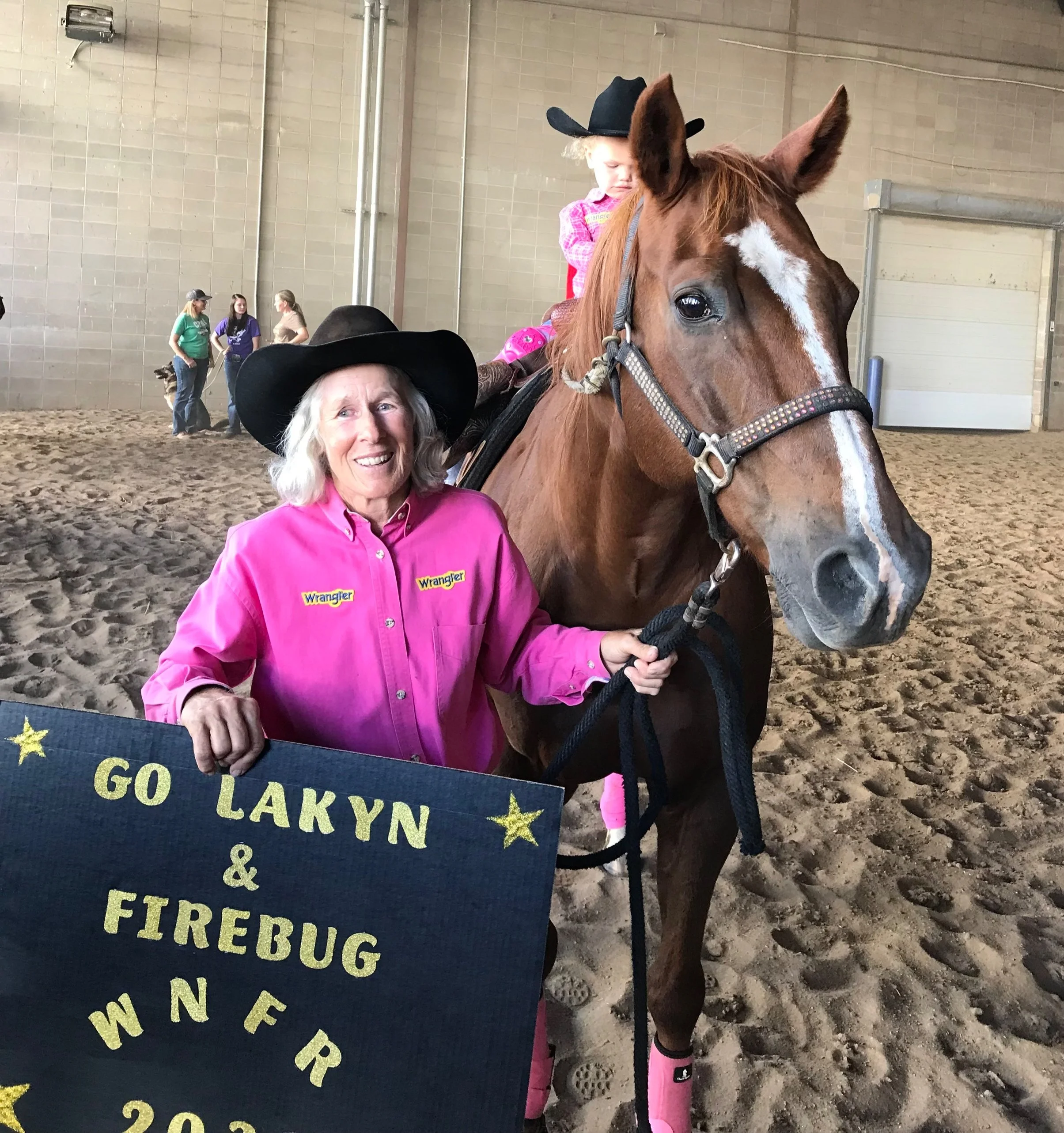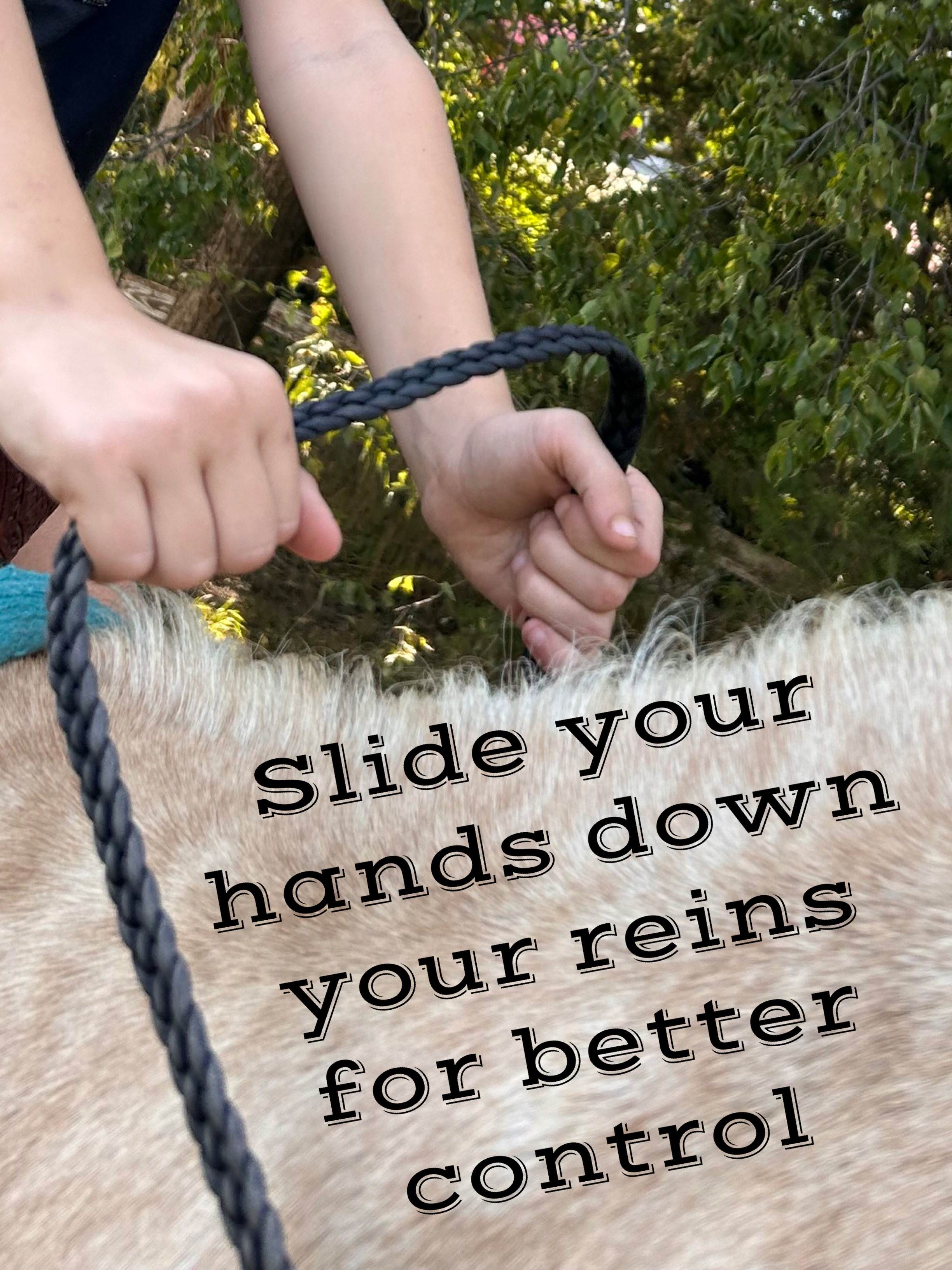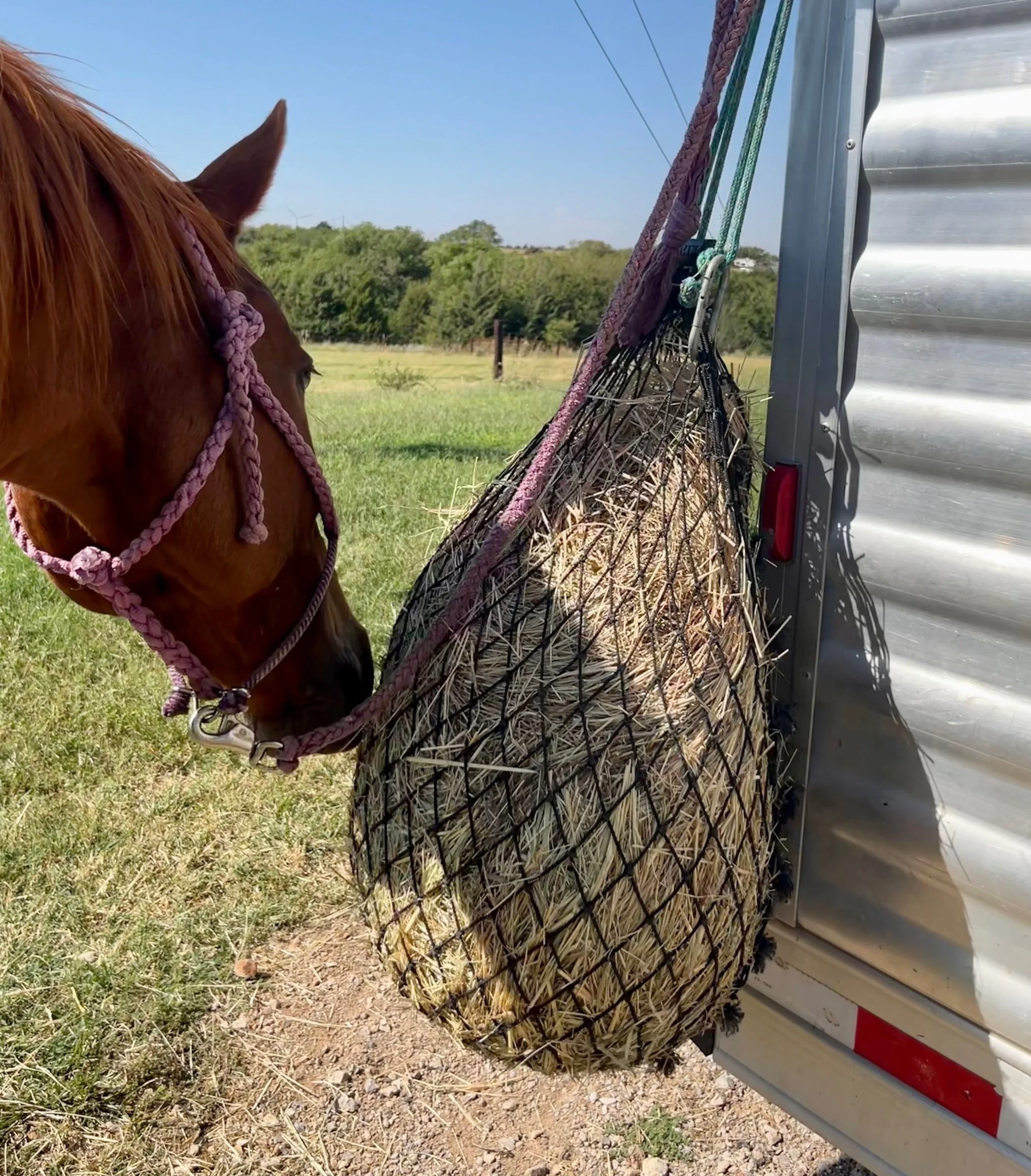Cowkids Only - October 2023
October 2023
Brought to you by The Bell Mare Book Company
Ask a Pro:
Jeanne Anderson
Jeanne Anderson is a 2-time National Finals Rodeo barrel racer and has trained many 1-D barrel horses throughout her career. She also has helped hundreds of kids perfect their barrel racing skills, including her nieces and great nieces. She is pictured here with her great niece, Lakyn, who dressed up as her aunt for a Halloween costume race. Not only did she dress up as Jeanne, but “Firebug,” the horse that took Jeanne to the NFR both times, is who Lakyn rode through the pattern.
Jeanne took a few minutes out of her very busy barrel horse training schedule to give us a few pointers for youth barrel racers.
Ask a Pro:
NFR Barrel Racer Jeanne Anderson
Question: What are three things you recommend youth barrel racers do in the practice pen?
Jeanne’s Answer:
Slow down. It’s fun to go fast. I get it. That’s why we are barrel racers. But taking your horse through the pattern more times at a walk or trot is going to help you perfect what you need to be doing and reinforce correctness in your horse. It is easier to build good habits at a slower speed.
Limit the number of times you make a run in the practice pen. I recommend making a practice run two times a week. For example, say you go to a rodeo on Sunday and your horse hits the third barrel. Monday and Tuesday you need to spend time going through the pattern slowly and practicing correctly. On Wednesday, make a run and see what happens. Then Thursday and Friday you do more slow work fixing whatever needs fixed from Wednesday’s run. Then make a run again Saturday and see if you fixed what you needed to. If you didn’t, spend two more days going slow and correct, then try again.
Don’t go to the practice pen every time you get on your horse. If you can do it safely, spend a day riding out in the pasture, track some cattle, ride bareback, just do something other than run barrels. Spending time improving your own riding skills will help you become a better barrel racer just as much, if not more, as actually working your horse on the barrel pattern.
Question: What are some common mistakes you see youth barrel racers make and how do you recommend fixing them?
Jeanne’s Answer:
Their reins are too long. This goes for adults too, but kids especially should have short reins when they are barrel racing. Short reins allow you to communicate with your horse without having to make big movements with your hands. Ultimately, this makes you develop softer, quieter hands. I recommend when you pull back on your reins the reins should be a few inches away from touching the saddle horn. The reins can’t be so short you have to lean forward to reach them, or you feel like the horse is pulling you forward, but they can’t be too long either.
Their hands are too close together. If you are riding two-handed to the barrels, you need to slide your hands down your reins. This helps you give better cues to your horse in the turns. In my opinion, the less you can do with your hands, the faster you will be. If you can pull the rein one inch and get a response from your horse, don’t pull two inches. Barrel racing is a balance of keeping control of the horse, without causing them to slow down. Keeping your reins short and your hands further apart really helps you do more communicating with less pulling.
They come in too close to the barrel and leave too far away. Your horse should be three to five feet away from the barrel when you start your turn. This space between your horse and the barrel as they approach the turn is often called a “pocket.” Having a big enough pocket allows your horse to have enough room coming into the turn so they can finish close to the barrel. When a horse leaves a barrel close to it, you will notice that puts them in line with their pocket for the next barrel. This is a more efficient way to turn the barrel and will make your runs faster.
They are not sitting up straight in their saddle. When you are going to a barrel, you should be centered in your saddle, not leaning into or away from the barrel. Your eyes should be looking at the dirt where you want your horse’s front feet to go (your pocket) and not at the barrel. Leaning and looking directly at the barrels are two common reasons for knocking a barrel over or having an incorrect turn.
They are in the wrong lead. When you are loping or running, your horse should be in the correct lead for whatever barrel you are turning. If you go to the right barrel first, your horse should be in the right lead for the first barrel and then switch to the left lead for the second and third. In the video below, watch my horse’s front legs going to each barrel. Do you see how one leg is “leading” the other? That is the lead he is in.
Question: What advice do you have for youth barrel racers who are stepping up to a faster horse?
Jeanne’s Answer:
When you step up to a faster horse, it should be a small step, not a big one. You want to find something very similar to what you are currently riding, but maybe a little younger or a little faster. However, they should not be a totally different horse than what you are used to. If you are familiar with the “D” system in barrel racing, you should move up one division. So if you are currently on a horse who consistently runs in the youth 4-D, your step-up horse should be a horse who consistently runs in the youth 3-D. Also, you are going to have to learn how to ride this horse, so choose a horse that will allow you to go through the pattern slowly so you can learn safely. Youth barrel horses should be able to make a run and then turn around and walk or trot the pattern without missing a beat.
Question: If you could get in a time machine and tell your younger self something, what would you say?
Jeanne’s Answer:
My parents were both horse trainers and they let me be part of their business. When I was younger, I would get frustrated because about the time I got a horse really going and was able to win on them, my parents would sell it and put me on something that needed more training. At the time, that was hard because I felt like I couldn’t win, but that process has paid off as an adult. I am able to ride all kinds of horses and fix all kinds of problems in horses because of the wide variety that I rode as a kid. I also am thankful that my parents made me take lessons in different disciplines even though I always knew I wanted to be a barrel racer. I learned how to ride jumping horses, dressage horses, reined cowhorses, cutting horses, you name it, I rode them. I wouldn’t trade that experience for anything now and I encourage youth riders to venture away from barrel racing now and then and learn from trainers outside of our sport too.
Jeanne Anderson at age 4 running barrels on her horse Speedy Coy.
Question: What is your favorite thing to read?
Jeanne’s Answer:
I want to learn everything I can about horses and a lot of that I get from reading website articles, magazines and books about horses. I try to keep up on everything related to horse health, nutrition and training. If I read something that is not about horses, it is probably still something non-fiction. I like to read to learn.
Cowkid Devotional
By High Call Ministries Pastor, Kelly Cronkhite
Kelly is not your typical pastor. He’s a Jesus-loving cowboy, rancher and roper.
Arena lights are a wonderful thing. They allow you to practice or compete even if it is dark outside. But, have you ever noticed that the lights only let you see what is inside the arena? If you look beyond the fence, it is still dark. This is similar to the way we are able to see our future compared to the way God can see our future. While we can only see what is clearly visible in the light, He can see beyond the lights and into the future plan He has created for us. This can be hard to understand when it feels like God takes something away that we love. For example, have you ever had a horse get sick or injured and you couldn’t ride them anymore? At the time, it probably made no sense why this had to be part of God’s plan for your life. But, remember, we only see what is clearly visible to us. God sees our entire future and is always working for our good. I have found often times when God takes something away, it is to make space for something better. Although you might not understand His plan right now, the Bible tells us God always has our best interest at heart and He will never leave us. In good times and in bad. When we understand our life’s path and when we don’t.
“As the heavens are higher than the earth, so are my ways higher than your ways and my thoughts higher than your thoughts.” - Isaiah, Chapter 55, Verse 9
“Your word is a lamp for my feet, a light on my path.” - Psalms, Chapter 119, Verse 105
Horse Care Tip of the Month
By Equine Veterinarian Zach Bruggen
Did you know horses only sleep for 2 to 4 hours per day? One quick nap is all they need! The other 20 to 22 hours a day they were meant to spend grazing. Their bodies were designed to take in small amounts of forage, which means grass and/or hay, for at least 20 hours of their day. If you can safely turn your horses out on pasture for most, or all, of the day, you should. If your horses have to spend their days in a pen or stall, make sure they have access to good hay at all times. Horses should consume about 1% of their body weight in grass or hay every day. The average-sized 1,000-pound horse needs to eat about 10 pounds of forage per day. If your horse is a fast eater or tends to be overweight, try feeding them out of a slow-feeder hay bag or net. This allows them to eat all day, without eating more than they should. Hay bags also are a good idea when you are competing. If horses exercise on an empty stomach, they can develop gastric ulcers, which are painful sores in their stomach. If you offer your horse access to hay when they are resting at the trailer between your events, this can reduce their chances of ulcers. Allowing your horses to eat the way God intended will make them happier and healthier!
Horses should graze 20 or more hours EVERY DAY!
If your horse is overweight or a fast eater, try feeding them out of a slow-feed hay bag. Having to pull the hay out of the small holes will allow them to eat most of the day, without letting them eat more than they should. Be careful to hang hay bags high enough the horse can’t get their foot caught in the net.
Exercise of the Month
By Logan Corbett, with Champion Living Fitness and strength coach for many professional rodeo athletes
Usually when you hear the word “dead bug,” you don’t think of exercise. What kind of bug do you picture? Well, today, when we talk about dead bugs, we are actually talking about an exercise that can help improve your strength and balance. No matter what event you do, dead bugs are a great exercise for all rodeo athletes. They are especially helpful for:
Steer wrestlers, tie-down ropers, breakaway ropers and team ropers staying with their horse as they leave the box
Roughtstock riders driving over the front of a sheep, calf, steer or bull
Barrel racers and pole benders staying centered in the saddle through the turns and as the horse leaves for the next barrel or pole
Goat tiers and tie-down ropers trying to improve their get offs and flanks
Dead bugs work your stomach, or abdominal, muscles, which helps your body stay more balanced and in control when you are riding. I like dead bugs because they are a functional exercise for rodeo competitors. They mimic the movements and demands placed on a rodeo athlete’s body during a ride.
To perform a dead bug, lay on the floor on your back. This exercise should be performed on carpet, a rug or an exercise mat so you don’t hurt your back. Start with your legs straight and feet flexed toward your face. Then raise both legs until they are directly above your hips (the bottoms of your feet facing the ceiling.) Straighten both arms and place them above your shoulders (fingertips pointed to the ceiling.) You should look like a dead bug laying on your back with your legs and arms stretched up. Then, move your right leg and right arm away from your body until your heel and thumb almost touch the ground. Keep your lower back pressed into the floor. If your lower back is wanting to come off the floor, don’t lower your leg and arm as low. Bring the right leg and arm back up to their dead bug position. Repeat the same movement on the other side. (see video below for example). Try doing this six times on each side and then take a break. Repeat the exercise six times on each side, two to three more times every day to get the best results. Until next time, train to win!
Rodeo Word of the Month:
Riggin
Riggin
To stay on a bareback horse, cowboys use a “riggin.” A riggin looks similar to a suitcase handle and is made up of leather and rawhide. The riggin is placed on the bucking horse’s withers and held on with a cinch. Each cowboy has their own personal riggin that is sized for their hand. The bareback rider puts his hand in a special glove and then wedges his hand in the strap of the riggin for the 8-second ride.
Rodeo Math Problem of the Month
Elsie and Max are traveling to a junior rodeo that is 140 miles from their house. If their parents drive at 70 miles per hour, how many hours will it take them to get to the rodeo? If the rodeo starts at 10 a.m. and they need an hour to pay their fees and warm up their horses, what time do they need to leave their house?
Rodeo Reading Comprehension
Problem of the Month
Short Go is an American Quarter Horse. His breed is known for their excellent cow sense and quick speed. Because Short Go is registered with The American Quarter Horse Association, he has registration papers that show the names of his parents, grandparents and great grandparents, along with his birthdate, color, gender and owners. Short Go is by a stallion known for making great ranch horses and out of a mare who was a cutting horse. Short Go’s birthday is March 1, 2008 and he is a bay gelding. What are three things you learned about Short Go from his registration papers?








